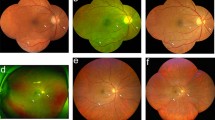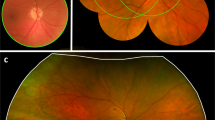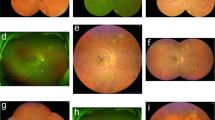Abstract
Objective
To examine the inter-observer agreement between two retina specialists in grading diabetic retinopathy (DR) severity in ultra-wide-field fundus photographs.
Methods
Two hundred and seventy patients with diabetes, who visited the vitreoretinal specialty at a tertiary eye care hospital, with or without DR underwent comprehensive ophthalmic examination, dilated retinal exam and Optos ultra-wide-field (UWF) retinal photography. Optos images were graded for DR severity based on the International Clinical Diabetic Retinopathy Disease Severity Scale by two retina specialists with same number of years of experience, masked to the clinical details of the participants.
Results
The two graders showed agreement in 229/270 images (84.8%) and disagreement in 41/270 images (15.2%). The unweighted kappa for agreement between graders was k = 0.715, SE = 0.037 and the weighted kappa was k = 0.838, SE = 0.022. No DR was identified in 170/270 (62.9%) patients, mild NPDR in 15/270 (5.6%) patients, moderate NPDR in 35/270 (12.9%) patients, severe NPDR in 4/270 (1.48%) patient and PDR in 5/270 (1.85%) patients by both graders. Disagreement was neither related to the learning curve of graders nor with the patient’s age (p = 0.574), gender (p = 0.169), duration of diabetes (0.660) or the lens being phakic or pseudophakic (p = 0.171) on logistic regression.
Conclusions
The impact of disagreement noted between observers in grading DR on UWF fundus photographs should be considered when utilizing UWF system in clinical studies.
Similar content being viewed by others
Log in or create a free account to read this content
Gain free access to this article, as well as selected content from this journal and more on nature.com
or
Data availability
Data are available from the corresponding author upon reasonable request.
References
Early treatment diabetic retinopathy study research group. Grading diabetic retinopathy from stereoscopic color fundus photographs–an extension of the modified Airlie House classification. ETDRS report number 10. Ophthalmology. 1991;98:786–806.
Aiello LP, Odia I, Glassman AR, Melia M, Jampol LM, Bressler NM, et al. Diabetic Retinopathy Clinical Research Network. Comparison of Early Treatment Diabetic Retinopathy Study standard 7-field imaging with ultrawide-field imaging for determining severity of diabetic retinopathy. JAMA Ophthalmol. 2019;137:65–73.
Ghasemi Falavarjani K, Tsui I, Sadda SR. Ultra-wide-field imaging in diabetic retinopathy. Vis Res. 2017;139:187–90.
Silva PS, Cavallerano JD, Sun JK, Soliman AZ, Aiello LM, Aiello LP. Peripheral lesions identified by mydriatic ultrawide field imaging: distribution and potential impact on diabetic retinopathy severity. Ophthalmology. 2013;120:2587–95.
Wessel MM, Aaker GD, Parlitsis G, Cho M, D’Amico DJ, Kiss S. Ultra-wide-field angiography improves the detection and classification of diabetic retinopathy. Retina. 2012;32:785–91.
Liu SL, Mahon LW, Klar NS, Schulz DC, Gonder JR, Hramiak IM, et al. A randomised trial of non-mydriatic ultra-wide field retinal imaging versus usual care to screen for diabetic eye disease: rationale and protocol for the Clearsight trial. BMJ Open. 2017;7:e015382 https://doi.org/10.1136/bmjopen-2016-015382.
Talks SJ, Manjunath V, Steel DH, Peto T, Taylor R. New vessels detected on wide-field imaging compared to two-field and seven-field imaging: implications for diabetic retinopathy screening image analysis. Br J Ophthalmol. 2015;99:1606–9.
Li S, Wang JJ, Li HY, Wang W, Tian M, Lang XQ, et al. Performance evaluation of two fundus oculi angiographic imaging system: Optos 200Tx and Heidelberg Spectralis. Exp Ther Med. 2021;21:19.
Ruamviboonsuk P, Teerasuwanajak K, Tiensuwan M, Yuttitham K. Thai Screening for Diabetic Retinopathy Study Group. Interobserver agreement in the interpretation of single-field digital fundus images for diabetic retinopathy screening. Ophthalmology. 2006;113:826–32.
Wilkinson CP, Ferris FL 3rd, Klein RE, Lee PP, Agardh CD, Davis M, et al. Global Diabetic Retinopathy Project Group. Proposed international clinical diabetic retinopathy and diabetic macular edema disease severity scales. Ophthalmology. 2003;110:1677–82.
Horton MB, Brady CJ, Cavallerano J, Abramoff M, Barker G, Chiang MF, et al. Practice guidelines for ocular telehealth-diabetic retinopathy, Third Edition. Telemed J E Health. 2020;26:495–43.
Price LD, Au S, Chong NV. Optomap ultrawide field imaging identifies additional retinal abnormalities in patients with diabetic retinopathy. Clin Ophthalmol. 2015;9:527–31.
Landis JR, Koch GG. The measurement of observer agreement for categorical data. Biometrics. 1977;33:159–74.
Gadkari SS, Maskati QB, Nayak BK. Prevalence of diabetic retinopathy in India: The All India Ophthalmological Society Diabetic Retinopathy Eye Screening Study 2014. Indian J Ophthalmol. 2016;64:38–44.
Raman R, Rani PK, ReddiRachepalle S, Gnanamoorthy P, Uthra S, Kumaramanickavel G, et al. Prevalence of diabetic retinopathy in India: SankaraNethralaya Diabetic Retinopathy Epidemiology and Molecular Genetics Study report 2. Ophthalmology. 2009;116:311–8.
Mackenzie PJ, Russell M, Ma PE, Isbister CM, Maberley DA. Sensitivity and specificity of the Optosoptomap for detecting peripheral retinal lesions. Retina. 2007;27:1119–24.
Hirano T, Imai A, Kasamatsu H, Kakihara S, Toriyama Y, Murata T. Assessment of diabetic retinopathy using two ultra-wide-field fundus imaging systems, the Clarus® and Optos™ systems. BMC Ophthalmol. 2018;18:1–7.
Spaide RF. Peripheral areas of nonperfusion in treated central retinal vein occlusion as imaged by wide-field fluorescein angiography. Retina. 2011;31:829–37.
Byberg S, Vistisen D, Diaz L, Charles MH, Hajari JN, Valerius M, et al. Optos wide-field imaging versus conventional camera imaging in Danish patients with type 2 diabetes. Acta Ophthalmol. 2019;97:815–20.
Verma A, Alagorie AR, Ramasamy K, van Hemert J, Yadav NK, Pappuru RR, et al. Indian Retina Research Associates (IRRA). Distribution of peripheral lesions identified by mydriatic ultra-wide field fundus imaging in diabetic retinopathy. Graefes Arch Clin Exp Ophthalmol. 2020;258:725–33.
Abramoff MD, Folk JC, Han DP, Walker JD, Williams DF, Russell SR, et al. Automated analysis of retinal images for detection of referable diabetic retinopathy. JAMA Ophthalmol. 2013;131:351–7.
Silva PS, Cavallerano JD, Sun JK, Noble J, Aiello LM, Aiello LP. Nonmydriatic ultrawide field retinal imaging compared with dilated standard 7‐field 35‐mm photography and retinal specialist examination for evaluation of diabetic retinopathy. Am J Ophthalmol. 2012;154:549–59.
Ghasemi Falavarjani K, Wang K, Khadamy J, Sadda SR. Ultra-wide-field imaging in diabetic retinopathy; an overview. J Curr Ophthalmol. 2016;28:57–60.
Rasmussen ML, Broe R, Frydkjaer-Olsen U, Olsen BS, Mortensen HB, Peto T, et al. Comparison between early treatment diabetic retinopathy study 7-field retinal photos and non-mydriatic, mydriatic and mydriatic steered widefield scanning laser ophthalmoscopy for assessment of diabetic retinopathy. J Diabetes Complicat. 2015;29:99–104.
Author contributions
SS, RRN designed the study for the funding; SS screened and examined patients, obtained data and images, performed statistical analysis; SRS, CCN, VJP graded optos images; SS, SSD, MB interpreted the results; SS wrote the paper; all authors provided critical scientific comments and approved the content of the manuscript.
Funding
This work was supported by the DBT/Wellcome Trust India Alliance Fellowship [grant number IA/CPHE/16/1/502670] awarded to Dr Sangeetha Srinivasan as per funder’s guidelines.
Author information
Authors and Affiliations
Corresponding author
Ethics declarations
Competing interests
The authors declare no competing interests.
Additional information
Publisher’s note Springer Nature remains neutral with regard to jurisdictional claims in published maps and institutional affiliations.
Rights and permissions
About this article
Cite this article
Srinivasan, S., Suresh, S., Chendilnathan, C. et al. Inter-observer agreement in grading severity of diabetic retinopathy in wide-field fundus photographs. Eye 37, 1231–1235 (2023). https://doi.org/10.1038/s41433-022-02107-1
Received:
Revised:
Accepted:
Published:
Issue date:
DOI: https://doi.org/10.1038/s41433-022-02107-1



